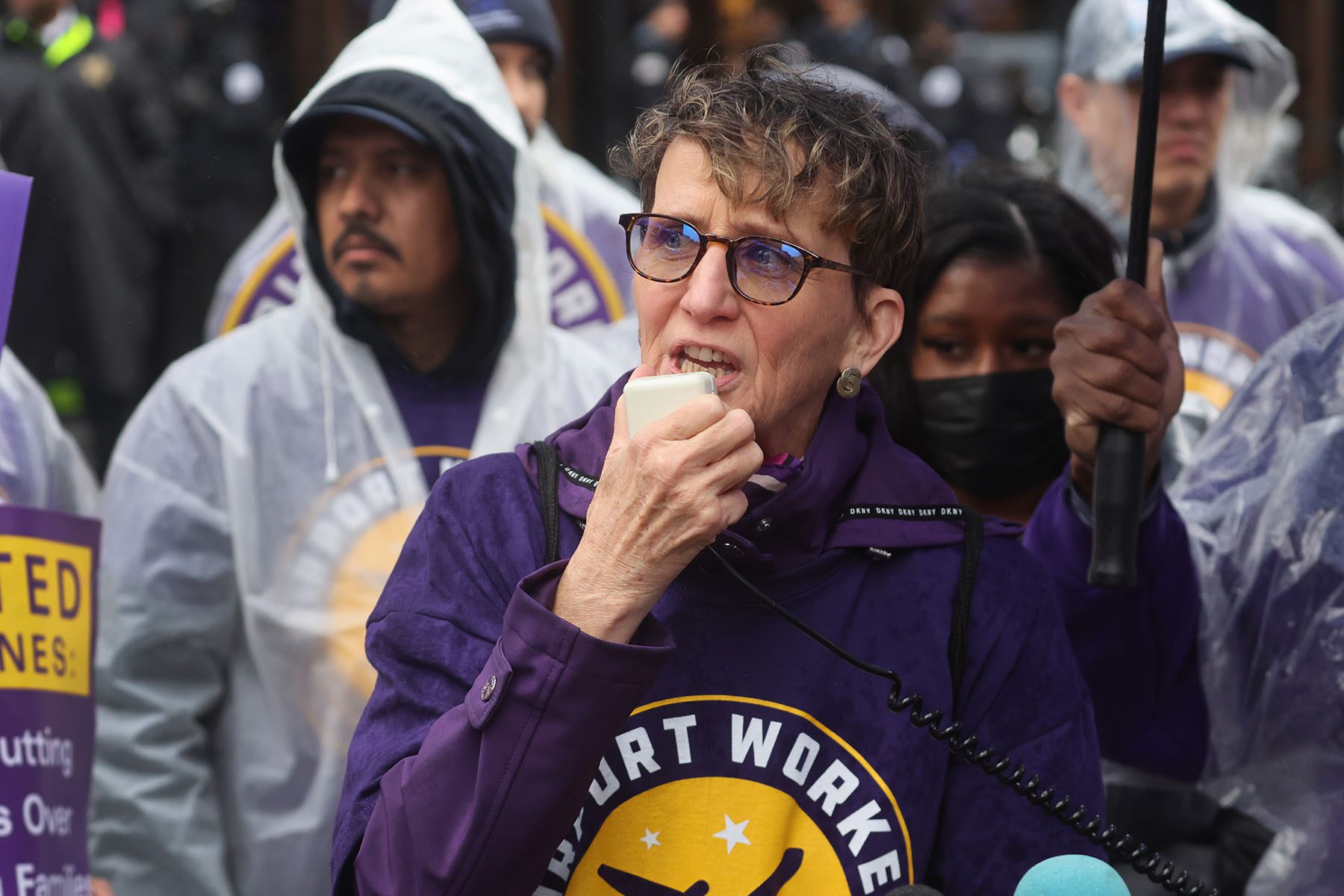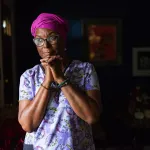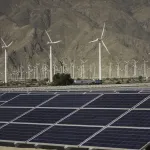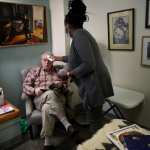When Democratic policymakers including Rep. Alexandra Ocasio Cortez and Sen. Ed Markey tout their Green New Deal legislation, they are usually speaking about climate-related jobs — employment in clean energy production, environmental restoration or climate adaptation work in cities.
Their overarching goal is to create policies and jobs that will transition the country in a way that centers low-income communities of color — those most impacted by the climate crisis.
Mary Kay Henry, the first woman president of the Service Employees International Union and a supporter of the legislation, wants the country to consider incorporating another class of workers all together in climate policy: care workers. The SEIU represents about 2 million workers, including more than 800,000 home care workers, most of whom are women, Henry said.
It’s why SEIU partnered with the Green New Deal Network for a series of protests last month, to present a united front on climate and care work as they urged Congress to pass Build Back Better legislation before the midterms, which included $500 billion for climate action and $150 billion in home care funding. The bill has been stalled for months, with no support from Republicans and opposition from two Democratic senators blocking its passage.
Henry argues that a stable care force could play a crucial role in helping communities adapt and survive a future replete with worsening natural disasters like wildfires, heat waves, hurricanes and flooding events.
Including care work in the fight for climate action could also broaden opportunities for women.
Clean energy jobs, which pay on average $25 an hour, are still overwhelmingly held by men. Care jobs, on the other hand, pay on average $13.51 an hour and are predominantly filled by women, women of color and immigrants. Most workers don’t receive any additional benefits like retirement funds or health care, according to the Economic Policy Institute.
The 19th spoke with Henry about the reasons for linking these two policy priorities, the role care work can play in a green economy and how her union pushes for climate-friendly legislation across the country.
This interview has been edited for length and clarity.
How did SEIU become involved in climate change work? How are care workers being impacted by the climate crisis?
Our members live in the most polluted ZIP codes in the country. And their children are experiencing disproportionate rates of asthma and cancer. So our members and their families have made us part of this movement in a louder and louder way.
We have nursing home workers and janitors whose children were poisoned in Flint by the water crisis. We have school workers and health care workers on the island of Puerto Rico who have been devastated by Hurricane Maria and the lack of response in the subsequent storms. We have members who have contended with floods and wildfires and tornadoes.
Most recently, our home care workers have done these extraordinary acts of courage. When communities are told to evacuate in a fire, oftentimes our home care workers and their clients don’t have the resources to evacuate. One example is Maria Alvarez, a home care worker from Santa Paula, California. She was caring for her client Alex in 2018 when a wildfire erupted. She couldn’t evacuate Alex because he’s confined to his bed and she wasn’t able to carry him. When the power failed, she took over for the machine that keeps him breathing on a regular basis and manually kept his airway open and his lungs pumping. She did this for two whole days and nights keeping him alive.
We also have the stories of loss of life both in Northern California, Oregon and Washington of our home care members and their clients who were impacted because they couldn’t evacuate.
It’s made our union understand and the climate movement understand that the fight to invest in caregiving and the fight to stop climate change are inextricably linked in the lives of our members.
What role do care workers play in helping society adapt to climate change or to contend with these disasters?
There’s a groundbreaking effort by our California home care workers called the Home Care Resilience Program. Our home care local (unit) was able to convince the governor and state legislature that they needed to invest in home care workers as part of the first responder system, because they’re often in isolated areas. They are now being trained in California to help firefighters as first responders, creating a safer way to help people that don’t have resources.
We know that these frontline workers are essential to the ongoing functioning of our society, both for the home care crisis, as we all age, and the childcare crisis, as moms and dads have left the paid workforce in order to care for their kids.
And the pandemic has shown us that frontline workers are not safe, protected or supported by their employers to take care of themselves and their families. So all of us pay the price for that.
What would it look like if we included care workers in a just transition, a concept I think most people associate more with clean energy jobs?
We know the impacts of climate change are being felt unevenly across socioeconomic lines and that the poor and vulnerable are disproportionately at risk. So I think, to invest in care is to advance the resilience that our communities need to meet the challenge of the climate crisis.
We know that the number of seniors and people with disabilities who are going to be impacted by climate disasters and environmental injustice is expected to double by 2050. And so I think what it would look like is it expands how resilient we are as a society by investment in care work. And it helps us think about these interlocking emergencies: the aging of the population and the isolation of caregivers and their clients in especially rural areas where they don’t have the resources they need to contend with the escalating weather disasters that are unfolding in terms of floods and wildfires.
You were part of recent protests around Earth Day calling for climate action. What specific policies either on the state level or federal level is SEIU supporting? What would you like to see passed while Democrats still have the majority?
Well, we’re continuing to fight for the investment in climate and care as part of this Senate’s deliberation about whether there’s going to be another reconciliation bill that creates millions of good-paying union jobs in clean energy, home care, and addresses racial and economic inequities, and finally tackles climate change.
We just did a West Virginia video town hall this weekend that 4,000 West Virginians participated in that was driving calls to [Sen. Joe] Manchin about trying to address those things. [Manchin is one of two Democrats who has opposed some of the Build Back Better legislation.]
At the state level, there’s a million things that we are doing. We’re pursuing both investment in care and innovative climate work that’s not being led by our union, but that we’re backing, like healthy schools and solar in schools initiatives. And this home care resilience program I was talking about, we’re now going to try and take it national.
Finally, as the first woman president of SEIU, what role do you see gender playing in discussions of the economy and climate action?
I think that investing in child care and home care work is a way to right a historical wrong that was done when those jobs were excluded from all of the New Deal advances in the ’30s. Both home care and child care jobs have been excluded from the Fair Labor Standards Act, Social Security, overtime pay, unemployment, health insurance, all of those things.
So we’ve had to fight state by state, place by place, collective bargaining agreement by collective bargaining agreement, for basic rights for work that has been done by women.
Investing in care work is a way to send a message that we value labor that has been done primarily by women since the beginning of time. And that if we want to upgrade this work, which is the fastest-growing job in the U.S. economy, we’re going to lift up all other jobs in the economy.





